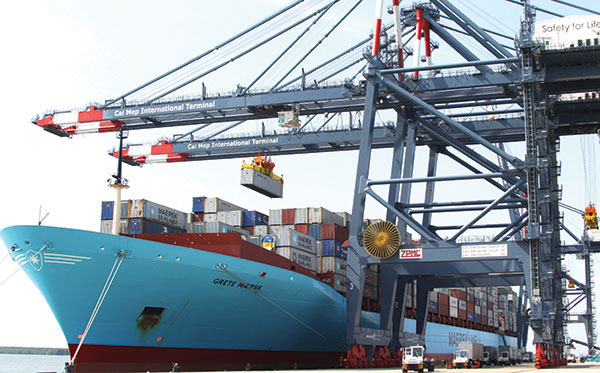Cai Mep: Portal to the Pacific
 |
| Nguyen Xuan Ky |
The Cai Mep-Thi Vai port area, in the southern province of Ba Ria-Vung Tau, not only functions as a gateway port for the southern economic hub, but is also set to become an important transhipment port.
The Cai Mep-Thi Vai port area is now home to seven ports, including SP-PSA (a joint venture between Vinalines and Singaporean PSA), TCCT, TCIT, CMIT (backed by Vinalines and Danish company APMT), TCTT, and SSIT (backed by Vinalines and US firm Carrix/SSA).
Gateway to the south
All containers exported to the US and a majority of those shipped to Europe from the southern key economic region are loaded directly onto mother vessels in the Cai Mep area. the country’s exports, may just behind Malaysia’s, are being connected with foreign markets by the best way, much better than exports of Thailand, Indonesia and Philippines.
Cai Mep-Thi Vai ports accommodate 10 direct services to the US weekly, with deployed vessel capacity at 8,000-9,000 twenty-foot equivalent units (TEU). Three of those berth at CMIT, while the remaining seven services anchor at the three terminals of Saigon New Port.
For imports and exports from and to the European market, there are three weekly mainline services connecting directly with Europe. One of them calls at TCIT while the remaining two dock at CMIT, which deploys vessels with capacities up to 14,000-15,000TEU.
Terminals in Cai Mep-Thi Vai also berth seven services dedicated to intra-Asia imports and exports.
 |
| With seven ports and an 18,000TEU capacity on the horizon, Cai Mep-Thi Vai’s ports are making waves |
Transhipment
Goods transhipment from northern and central Vietnam has picked up with CMIT’s two weekly mainliner services direct to Europe. These services are deployed by Ocean 3 and CKY(H)E alliances, featuring vessels with 14,000TEU capacities. Along with the four domestic feeder services per week that call at the Cai Mep area, good conditions are in place to develop domestic transhipment.
Currently, CMIT is preparing a trial berth for 18,000TEU vessels. A successful trial will provide greater opportunities for Cai Mep to take over transhipment from Malaysian and Singaporean ports, with domestic feeders from northern and central Vietnam providing inputs. This will be also a good opportunity to enhance co-operation between the terminals in the port complex.
For international transhipment, mega transhipment hubs like Tanjung Pelepas in Malaysia, SCCT in Egypt, or Tangier in Morocco are no longer popular. Shipping lines and alliances have formed their own transhipment hubs a long time ago. On the condition that berths in Cai Mep can practise better co-operation and customs procedures for transhipment at Cai Mep are relaxed, Cai Mep will be in position to act as a gateway port and attract larger volumes of internationally-transhipped goods.
Increasing operational efficiency
In 2016, the global shipping market witnessed many changes due to the formation of alliances between a number of shipping firms, and numerous mergers and acquisitions in the sector. These changes impacted Vietnamese ports, especially those in Cai Mep.
Container throughput at Cai Mep in 2016 rose 36 per cent on-year, placing the area’s ports among those with the highest growth rates in the world as they did last year (with growth rate at 28.2 per cent), according to the Alphaliner-TOP 100’s ranking.
In October 2016, CMIT was also voted one of the top four Asian port operators by Lloyd’s List.
In order to increase operational efficiency, ports in Cai Mep-Thi Vai should strengthen co-operation to enable them to simultaneously accommodate more mainliners at the combined berths, increasing operational capacity and providing more flexibility to customers.
Cai Mep’s channel has been dredged continuously to enable it to accommodate ultra-large container vessels of up to 160,000 deadweight tonnes. It is necessary to dredge the channel in Cai Mep to a 15.5m depth to meet the demands of larger vessels, as the majority of vessels operating on the Asia-Europe route have a capacity of at least 18,000TEU. This need will only increase in the future, with orders of 20,000TEU vessels from carriers.
The “port authority” model is a successful administrative model applied at many big ports around the world. A similar model will be applied in the Cai Mep-Thi Vai port area – the “Port Management Board”. The establishment of such a board with functions similar to a port authority will help manage investment and competition activities in a strict, strategy-centric manner. Cargoes allocated among port complexes will also be regulated more efficiently, and infrastructure connecting ports will be developed more quickly.
What the stars mean:
★ Poor ★ ★ Promising ★★★ Good ★★★★ Very good ★★★★★ Exceptional
Latest News
More News
- Vietnam advances three-pillar strategy to prevent cervical cancer (December 12, 2025 | 20:00)
- MCH shares secure approval for listing on HSX (December 12, 2025 | 12:59)
- Raising product quality to secure Vietnam’s position in US market (December 11, 2025 | 12:00)
- Energy efficiency in buildings tops organisations’ infrastructure priorities (December 11, 2025 | 10:40)
- How smart infrastructure and digitalisation power the systemic transition (December 11, 2025 | 10:00)
- New law passed to strengthen technology transfer (December 11, 2025 | 10:00)
- New Law on High Technology sets incentives and safeguards (December 11, 2025 | 09:00)
- Lawmakers split over VAT on fertilisers and animal feed (December 10, 2025 | 18:56)
- Kim Long deal marks turning point for Vietnam’s auto industry (December 10, 2025 | 18:44)
- Pernod Ricard Vietnam supports flood-hit localities (December 10, 2025 | 14:18)
















 Mobile Version
Mobile Version